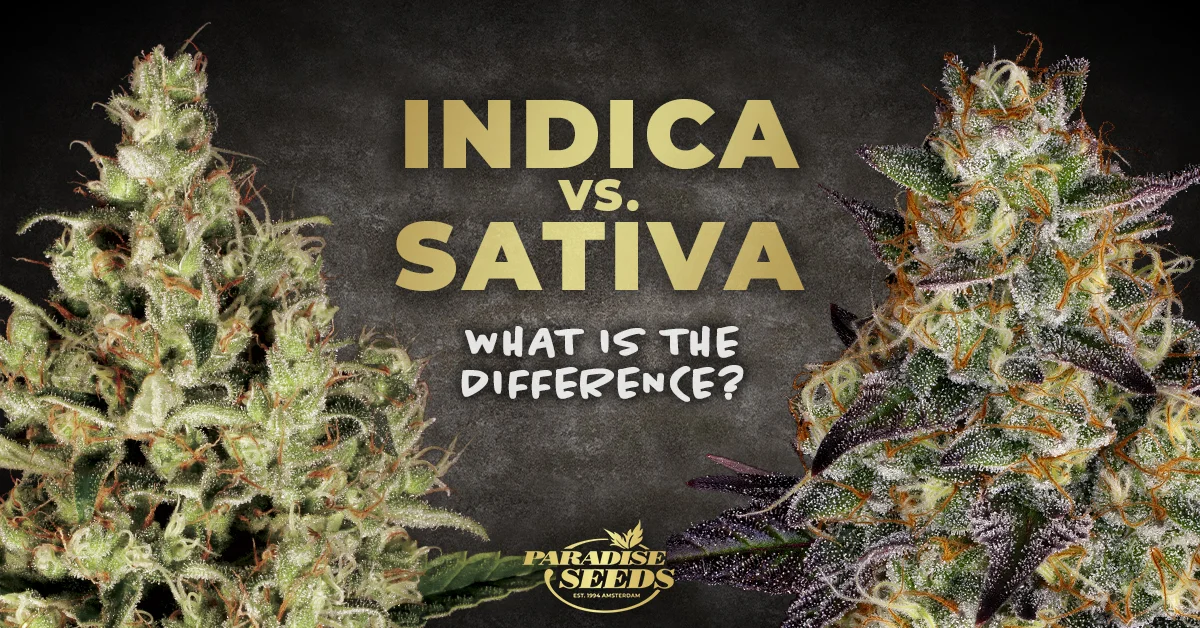Indica vs sativa, what is the difference? If you are new to exploring the joys of weed or making a grow with your first batch of cannabis seeds then you will no doubt be aware of these terms, which feature heavily in the categorisation of different marijuana strains. However there is more to this topic than first meets the eye, so let’s take a closer look:
Indica vs Sativa: Which are you?
Are you an Indica type? Do you enjoy weed which brings swift and strong relaxation and a sense of well-being that allows you to euphorically slip into the cosiness of the couch and submerge yourself into a good movie or a video game session? Classic Paradise indicas (where the indica percentage is higher than 60%) are El Dorado OG, Californian Gold and White Berry.
Are you a Sativa type? Do you enjoy weed which brings an uplift of energy and sense of clarity that allows you to happily get stuck in to creative tasks with your mind whirring, happy to be distracted by the sudden urge to clean under the couch? Classic sativas in the Paradise Seeds collection (where the percentage is higher than 60%) are Delahaze, L.A. Amnesia and Chocolate Wafflez.
While these are slightly exaggerated caricatures, the indica effect is generally linked with relaxation while the sativa effect is linked with energy, which is why indica is often known as a ‘night time smoke’, while sativa is referred to as a ‘day time smoke’ (also good for going out and socialising at night!).
What’s the difference between indica and sativa plants?
New customers to Paradise will often ask if there is a difference between indica and sativa. The answer is yes! The appearance of a particular cannabis plant was one of the traditional tests to assess its indica or sativa status. Typically indica weed plants are recognised as being shorter and more bushy with wider leaves, fatter buds and a faster finish time. This differentiation between cannabis plants was made following research by the work of biologists in the 19th and 20th century who noticed the different growth patterns amongst marijuana plants growing in the mountainous regions of Afghanistan (indicas are also common in India and Pakistan).
Sativa plants by contrast display a different growth pattern, tending to grow tall and more spindly, with narrower leaves. They tend to finish later and produce thinner and longer buds. Sativa landraces are commonly found close to the equator in South America, Africa and Southeast Asia and their growth patterns may have evolved to cope with conditions characterised by less water.
Nevertheless, as we will see later in this article, these days few strains are out-and-out sativas or indicas, due to many years of breeding. In the Paradise Seeds collection, Durga Mata, a 90% indica bred from Afghani and Himalayan landraces is perhaps the closest to a pure indica. Therefore, you will frequently see a strain described as ‘mostly’ sativa or sativa ‘dominant’.
Indica, sativa and the entourage effect debate
However, it seems that the question of the difference between indica and sativa gets more complicated as time goes on and has now become a subject of debate. For many years, sativa and indica were convenient labels used to differentiate cannabis plants, based on appearance and effect. However, with more scientific study entering the debate, these simple labels are increasingly seen as out of date.
In recent year, there has been more of a focus on the entourage effect which is the process by which various compounds (cannabinoids and terpenes, essentially) of a particular weed strain or plant combine to produce the overall effect.
This new way of thinking appeared to share a light on the secrets of the cannabis plant and how it interacts with the body’s endocannabinoid system, however some in the science world have bitten back and dismissed this concept as marketing hype. In an article in the Scientific American, a neurobiologst from Columbia university, researching cannabis, is sceptical; ““The lay public has really taken on the notion of the entourage effect, but there’s not a lot of data.”
Indica, sativa and the hybrid weed strain
Another element in the difference between indica and sativa conversation is the hybrid factor. As the cannabis seed industry has grown (inevitably along with a demand for cannabis seeds), it has evolved a culture of ‘new strain’ hype in much the same way other consumer good sectors have. Hybrids – which combine the desired qualities from indica and sativa parent plants – have provided breeders with the perfect vehicle for developing new and wonderful strains with genetics (check out our explainer article on hybrid cannabis seeds and plants).
The truth is that most cannabis users enjoy a combination of the sativa and indica experience, however, just as with everything, they are guided by personal preference in their choices when purchasing feminized cannabis seeds.


